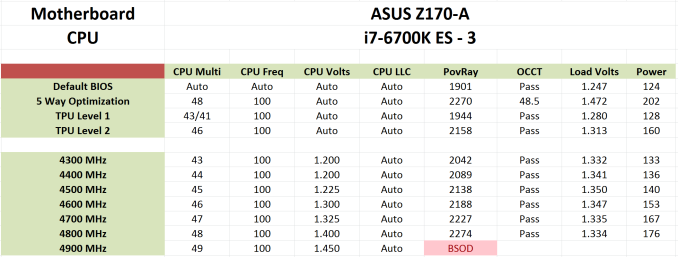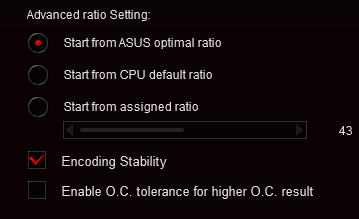The Intel Skylake i7-6700K Overclocking Performance Mini-Test to 4.8 GHz
by Ian Cutress on August 28, 2015 2:30 PM ESTFrequency Scaling
Below is an example of our results from overclock testing in a table that we publish in with both processor and motherboard. Our tests involve setting a multiplier and a frequency, some stress tests, and either raising the multiplier if successful or increasing the voltage at the point of failure/a blue screen. This methodology has worked well as a quick and dirty method to determine frequency, though lacks the subtly that seasoned overclockers might turn to in order to improve performance.
This was done on our ASUS Z170-A sample while it was being tested for review. When we applied ASUS's automatic overclock software tool, Auto-OC, it finalized an overclock at 4.8 GHz. This was higher than what we had seen with the same processor previously (even with the same cooler), so in true fashion I was skeptical as ASUS Auto-OC has been rather hopeful in the past. But it sailed through our standard stability tests easily, without reducing in overclocking once, meaning that it was not overheating by any means. As a result, I applied our short-form CPU tests in a recently developed automated script as an extra measure of stability.
These tests run in order of time taken, so last up was Handbrake converting a low quality film followed by a high quality 4K60 film. In low quality mode, all was golden. At 4K60, the system blue screened. I triple-checked with the same settings to confirm it wasn’t going through, and three blue screens makes a strike out. But therein is a funny thing – while this configuration was stable with our regular mixed-AVX test, the large-frame Handbrake conversion made it fall over.
So as part of this testing, from 4.2 GHz to 4.8 GHz, I ran our short-form CPU tests over and above the regular stability tests. These form the basis of the results in this mini-test. Lo and behold, it failed at 4.6 GHz as well in similar fashion – AVX in OCCT OK, but HandBrake large frame not so much. I looped back with ASUS about this, and they confirmed they had seen similar behavior specifically with HandBrake as well.
Users and CPU manufacturers tend to view stability in one of two ways. The basic way is as a pure binary yes/no. If the CPU ever fails in any circumstance, it is a no. When you buy a processor from Intel or AMD, that rated frequency is in the yes column (if it is cooled appropriately). This is why some processors seem to overclock like crazy from a low base frequency – because at that frequency, they are confirmed as working 100%. A number of users, particularly those who enjoy strangling a poor processor with Prime95 FFT torture tests for weeks on end, also take on this view. A pure binary yes/no is also hard for us to test in a time limited review cycle.
The other way of approaching stability is the sliding scale. At some point, the system is ‘stable enough’ for all intents and purposes. This is the situation we have here with Skylake – if you never go within 10 feet of HandBrake but enjoy gaming with a side of YouTube and/or streaming, or perhaps need to convert a few dozen images into a 3D model then the system is stable.
To that end, ASUS is implementing a new feature in its automatic overclocking tool. Along with the list of stress test and OC options, an additional checkbox for HandBrake style data paths has been added. This will mean that a system needs more voltage to cope, or will top out somewhere else. But the sliding scale has spoken.
Incidentally at IDF I spoke to Tom Vaughn, VP of MultiCoreWare (who develops the open source x265 HEVC video encoder and accompanying GUI interface). We discussed video transcoding, and I bought up this issue on Skylake. He stated that the issue was well known by MultiCoreWare for overclocked systems. Despite the prevalance of AVX testing software, x265 encoding with the right algorithms will push parts of the CPU beyond all others, and with large frames it can require large amounts of memory to be pushed around the caches at the same time, offering further permutations of stability. We also spoke about expanding our x265 tests, covering best case/worst case scenarios from a variety of file formats and sources, in an effort to pinpoint where stability can be a factor as well as overall performance. These might be integrated into future overclocking tests, so stay tuned.












103 Comments
View All Comments
kmmatney - Friday, August 28, 2015 - link
The G3258 is fun to overclock. The overclock on my Devils Canyon i5 made a difference on my server, which runs 3 minecraft servers at the same time. I needed the overclock to make up for the lousy optimization of Java on the WHS 2011 OS.StrangerGuy - Saturday, August 29, 2015 - link
Yeah, spend $340 on a 6700K, $200 on a mobo, $100 on a cooler for measly 15% CPU OC, all for a next to zero real world benefit in single GPU gaming loads compared to a $250 locked i5 / budget mobo.Who cares about how easy you can perform the OC when the value for money is rubbish.
hasseb64 - Saturday, August 29, 2015 - link
You nailed it stranger!Beaver M. - Saturday, August 29, 2015 - link
You should have known that before, that even without overclock your CPU will be so fast that you wont be seeing any difference in most games when overclocking.Deders - Saturday, August 29, 2015 - link
If you intend to keep the hardware for a long period of time it can help. My previous i5-750's 3800MHz overclock made it viable as a gaming processor for the 5 or so years I was using it.For example it allowed me to play Arkham City with full PhysX on a single 560TI, at stock speeds it wasn't playable with these settings. The most recent Batman game was no problem for it even though many people were having issues, same goes for Watchdogs.
qasdfdsaq - Wednesday, September 2, 2015 - link
Sure, and my 50% overclock on my i7 920 made it viable for my main gaming PC for a few years longer than it otherwise would have been, but a 10-15% overclock? With a <1% gaming performance increase? Meh.Impulses - Saturday, August 29, 2015 - link
You're exaggerating the basic requirements tho, I'm sure some do that, but I've never paid $200 or $100 for a cooler ($160/65 tops)... And if you spent more on the i7 it damn better had been for HT or you've no clue what you're doing...Xenonite - Saturday, August 29, 2015 - link
@V900: "Today, processors have gotten so fast, that even the cheap 200$ CPUs are "fast enough" for most tasks."For almost all non-gaming tasks (except realtime frame interpolation) this is most certainly true. The thing is, CPUs are NOT even nearly fast enough to game at 140+ fps with the 99% frame latency at a suitable <8mS value.
I realize that no one cares about >30fps gaming and that most people even condemn it as "looking to real" (in the same sentence as "your eyes can't even see a difference anyway"), therefore games aren't being optimised for low 99% frame latencies, and neither are modern CPUs.
But for the few of us who are sensitive to 1ms frametime variances in sub-10ms average frame latency streams, overclocking to high clock speeds is the only way to approach relatively smooth frame delivery.
On the same note, I would really have loved to see an FCAT or at least a FRAPS comparison of 99% frametimes between the different overclocked states, with a suitably overclocked GTX 980ti and some high-speed DDR4 memory along with the in-game settings being dialed back a bit (at least for the 1080p test).
EMM81 - Saturday, August 29, 2015 - link
"CPUs are NOT even nearly fast enough to game at 140+ fps" "But for the few of us who are sensitive to 1ms frametime variances in sub-10ms average frame latency streams"1) People may care about 30-60+fps but where do you get 140 from???
2) You are not sensitive to 1ms frametime variations...going from 33.3ms-16.7ms(30-60fps) makes only a very subtle difference to most people and that is a 16.6ms(0.5x) delta. There is zero possible way you can perceive anywhere near that level of difference. Even if we were talking about running at 60fps with a variation of 2ms and you could somehow stare at a side by side comparison until you maybe were able to pick out the difference why does it matter??? You care more about what the numbers say and how cool you think it is...
Communism - Saturday, August 29, 2015 - link
Take your pseudo-intellectualism elsewhere.